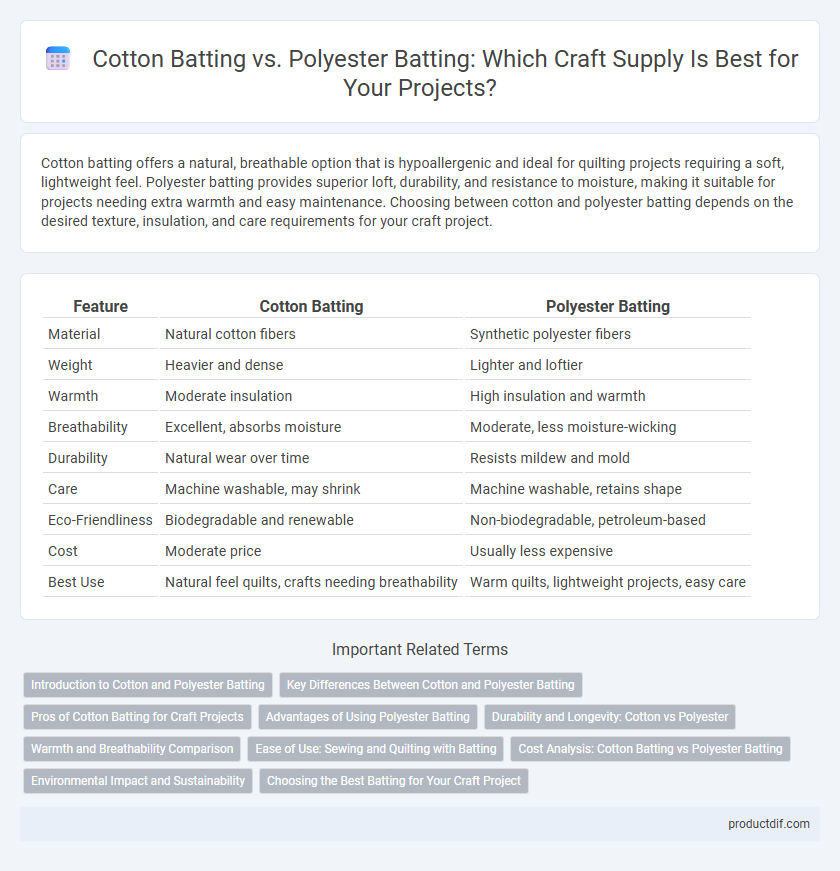Cotton batting offers a natural, breathable option that is hypoallergenic and ideal for quilting projects requiring a soft, lightweight feel. Polyester batting provides superior loft, durability, and resistance to moisture, making it suitable for projects needing extra warmth and easy maintenance. Choosing between cotton and polyester batting depends on the desired texture, insulation, and care requirements for your craft project.
Table of Comparison
| Feature | Cotton Batting | Polyester Batting |
|---|---|---|
| Material | Natural cotton fibers | Synthetic polyester fibers |
| Weight | Heavier and dense | Lighter and loftier |
| Warmth | Moderate insulation | High insulation and warmth |
| Breathability | Excellent, absorbs moisture | Moderate, less moisture-wicking |
| Durability | Natural wear over time | Resists mildew and mold |
| Care | Machine washable, may shrink | Machine washable, retains shape |
| Eco-Friendliness | Biodegradable and renewable | Non-biodegradable, petroleum-based |
| Cost | Moderate price | Usually less expensive |
| Best Use | Natural feel quilts, crafts needing breathability | Warm quilts, lightweight projects, easy care |
Introduction to Cotton and Polyester Batting
Cotton batting, made from natural cotton fibers, is favored for its breathability, softness, and eco-friendly qualities, making it ideal for quilts and garments requiring natural materials. Polyester batting, composed of synthetic fibers, offers greater loft, durability, and resistance to moisture and mildew, often used in projects needing lightweight insulation and long-lasting support. Both types serve critical roles in craft supplies, with their unique properties catering to different crafting needs and preferences.
Key Differences Between Cotton and Polyester Batting
Cotton batting is a natural fiber known for its breathability, softness, and excellent moisture absorption, making it ideal for quilts and garments requiring a cozy, natural feel. Polyester batting, composed of synthetic fibers, offers superior loft, durability, and resilience to shrinking and mildew, providing long-lasting support in cushions and heavy-use projects. Cotton batting tends to compress over time, while polyester maintains its thickness, influencing the choice based on project requirements for warmth, weight, and maintenance.
Pros of Cotton Batting for Craft Projects
Cotton batting offers natural breathability and moisture-wicking properties that make it ideal for craft projects requiring softness and durability. Its biodegradable and hypoallergenic nature ensures eco-friendly and safe use for sensitive skin, enhancing its appeal for handmade quilts and fabric crafts. The natural fibers of cotton batting also provide excellent texture and weight, contributing to a high-quality finish in various craft applications.
Advantages of Using Polyester Batting
Polyester batting offers superior durability and resistance to moisture, making it ideal for long-lasting craft projects and quilts. Unlike cotton, polyester maintains its loft and shape over time, providing consistent insulation and cushioning. Its lightweight and hypoallergenic properties also make polyester batting a versatile choice for various crafting applications.
Durability and Longevity: Cotton vs Polyester
Polyester batting offers superior durability and resistance to wear compared to cotton batting, maintaining loft and shape over extended use. Cotton batting, though breathable and natural, tends to compress and degrade more quickly with repeated washing and use. Choosing polyester batting ensures longer-lasting crafting projects due to its resilience against moisture and mildew.
Warmth and Breathability Comparison
Cotton batting offers superior breathability and natural moisture-wicking properties, making it ideal for projects requiring warmth without overheating. Polyester batting provides higher insulation and retains heat more effectively, though it tends to trap moisture and reduces airflow. Choosing between cotton and polyester batting depends on the desired balance of breathability and thermal retention for crafting needs.
Ease of Use: Sewing and Quilting with Batting
Cotton batting offers a natural fiber that is soft, breathable, and easy to sew, making it ideal for quilting projects requiring smooth stitching and less puckering. Polyester batting tends to be lightweight, resilient, and maintains loft well, but can be more slippery to handle and may require careful pinning during sewing to prevent shifting. Quilters often prefer cotton batting for traditional, warm quilts and polyester batting for projects needing durable, washable, and hypoallergenic materials.
Cost Analysis: Cotton Batting vs Polyester Batting
Cotton batting generally costs more than polyester batting due to its natural fiber content and eco-friendly appeal, placing it at a higher price point in craft supplies. Polyester batting offers a budget-friendly alternative, benefiting from synthetic production methods that reduce cost and provide consistent bulk and durability. For crafters balancing expense with quality, polyester batting represents a cost-effective solution, while cotton batting appeals to those prioritizing sustainability despite the premium price.
Environmental Impact and Sustainability
Cotton batting is biodegradable and derived from a renewable natural resource, making it a more environmentally friendly option compared to polyester batting, which is petroleum-based and non-biodegradable. The production of cotton batting involves less energy consumption and fewer harmful emissions, contributing to lower environmental impact. Polyester batting, while durable and resistant to moisture, contributes to microplastic pollution and relies on fossil fuels, raising concerns about long-term sustainability.
Choosing the Best Batting for Your Craft Project
Cotton batting offers natural breathability and softness, making it ideal for quilts that require warmth without bulk, while polyester batting provides lightweight durability and excellent loft retention suitable for projects needing structure and resilience. Evaluating the specific needs of your craft, such as desired texture, washing frequency, and allergy considerations, helps determine the best batting choice. For eco-conscious crafters, organic cotton batting supports sustainability, whereas polyester options often deliver budget-friendly and versatile performance.
Cotton Batting vs Polyester Batting Infographic

 productdif.com
productdif.com